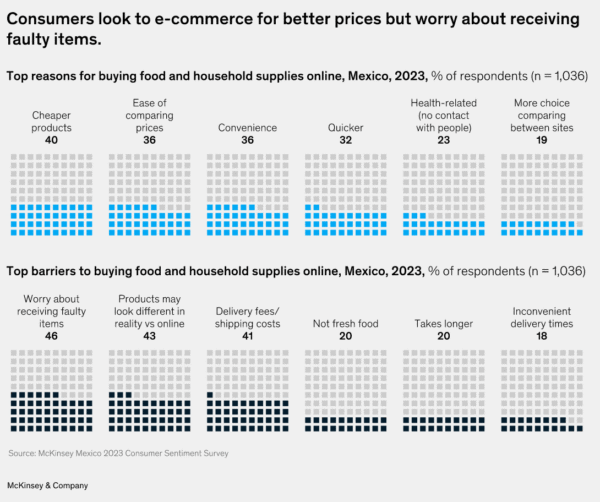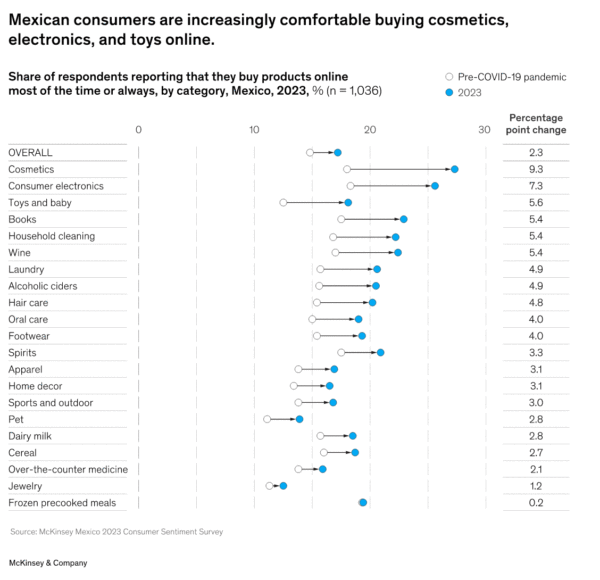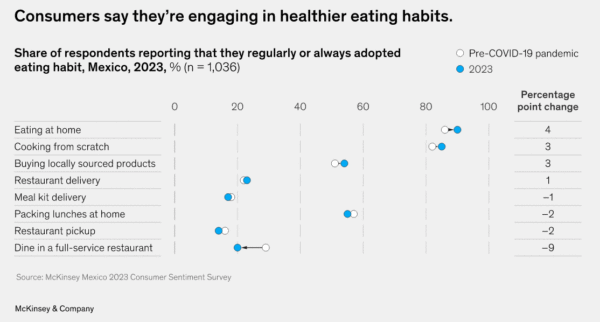Mexican consumers seek value and convenience—and find it online
July 8, 2023

By Fernando Hiraoka and Diego Martin Del Campo
Consumers in Mexico are feeling slightly more optimistic about both their country’s economy and their own ability to meet financial commitments in the coming year—but that doesn’t mean they’ve stopped looking for ways to spend less. In fact, their persistent quest for value is the main reason many of them continue to shop online: e-commerce still has a larger market share than it had before the COVID-19 pandemic. These are among the findings of a ConsumerWise survey conducted in early 2023 among more than 1,000 Mexican consumers across income groups. The following five charts show highlights from the survey.
Looking forward to better days. Thirty percent of Mexican consumers expect their finances to be in better shape this year than last year; they feel it will get easier to make good on their financial commitments. Indeed, there are hopeful signs: although inflation rates in Mexico in 2022 were the highest they’ve been in more than two decades, unemployment rates have returned to prepandemic levels. Real growth in consumption was significant, at 6.5 percent in 2022, according to Mexico’s National Institute of Statistics and Geography (INEGI). Overall, the percentage of Mexican consumers who feel optimistic about the country’s near-term economic future has risen to 46 percent, up from 44 percent in 2021 and 31 percent in 2020.

In search of cheaper options. The fraction of respondents who report cutting their spending in the past 12 months reached 67 percent, which is more than 20 percentage points above prepandemic levels. Furthermore, 23 percent of respondents—up from 20 percent in 2021—say that they’re trading down across their entire shopping basket. Most of the trade-down activity is happening in commoditized categories such as household cleaning products, laundry supplies, rice, pasta, and bottled water. And the trade-down trend has become more pronounced across all economic segments—in stark contrast to 2020 and 2021, when consumers in the highest-income segments who were trading up outnumbered the consumers in those segments who were trading down.

The pros and cons of e-commerce. Online shopping is no longer the main purchasing channel for Mexican consumers, as it was at the height of the pandemic, but its share is still higher than before the pandemic: 17 percent of respondents—compared with 15 percent prepandemic—say they do most or all of their shopping online. Consumers say they choose to shop online primarily because of price: they can find cheaper products, take advantage of more discounts, and easily compare prices across different retailers. They also find online shopping convenient. On the other hand, they do have some concerns about e-commerce—they worry about the possibility of receiving damaged or flawed products, discrepancies between online representations and reality, and high fees for delivery or shipping.
Consumers look to e-commerce for better prices but worry about receiving faulty items.

Buying low-risk categories online. According to our survey, the biggest shifts away from brick-and-mortar and toward e-commerce were in the following categories: cosmetics, consumer electronics, and toys and baby supplies. These trends are similar to e-commerce trends we have seen in more developed markets.

Opting for home-cooked meals. The pandemic shifted Mexican consumers toward new habits—such as eating at home, cooking from scratch, and buying locally sourced products—that are, in general, healthier. Our survey also shows that 25 percent of respondents consider low or no sugar as a very important factor in their food-purchasing decisions, and 60 percent say they’re willing to pay a premium for healthier products: 48 percent would pay “a bit more” (1 to 10 percent more) and 12 percent would pay “a lot more” (a premium of over 10 percent).

These survey results indicate that the pandemic has had lasting effects on consumer behavior in Mexico. Consumers continue to reduce their spending, shop online, and cook at home. As optimism about the economy rises, businesses will need to maintain their agility and respond quickly to meet the changing demands of their customers. For more detailed data and insights, email Co**********@******ey.com.
About the author(s)
- Fernando Hiraoka is a partner in McKinsey’s Mexico City office, where Diego Martin Del Campo is a consultant.
- This article was edited by Monica Toriello, an editorial director in the New York office.




























